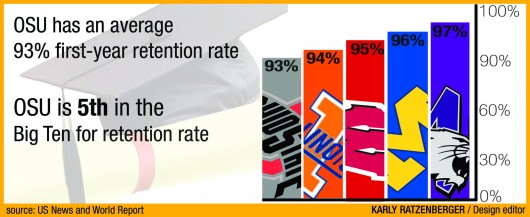Ohio State boasts an average 93 percent first-year retention rate, compared to the national average of about 66 percent, but one OSU official said the university can do more.
“We want to be A-plus. We want to be even better,” said Dolan Evanovich, vice president for strategic enrollment planning.
Evanovich said although OSU’s first-year retention rate as a whole is in the 90 percent range, the retention rates of commuter students and transfer students are typically about 84 to 85 percent.
“Although it’s still a very high rate, it’s pretty clear there’s a gap,” he said.
Evanovich said commuter students often have a harder time getting involved at OSU with the commute to and from classes and not automatically being on campus on evenings and weekends, and transfer students who have already gone through orientation at a different university can struggle to feel connected to OSU.
Andrew Hile is a fourth-year in mechanical engineering from Worthington who transferred from Michigan State after his first year. He said one of the challenges he experienced was getting involved in activities outside of classes.
“Coming in as a sophomore, I sort of thought I couldn’t get involved in things. I thought that you had to start as a freshman or it wasn’t worth it,” he said. “My friends (from high school who attended OSU) didn’t do very many clubs, so I didn’t really put myself out there to meet random people I had never met.”
Hile said, though, the combination of his friends and his adviser helped him transition.
“The engineering department was probably the biggest help in terms of feeling supported. My faculty adviser was helpful in terms of understanding what I can do as an engineering student,” he said. “(But) I wouldn’t say they played a significant role in helping me adapt to the school.”
Instead, Hile said his friend group and background as a Buckeye fan, having grown up in the Columbus area, helped him feel more like a part of the OSU culture.
Others said OSU actively tried to get them involved after transferring.
Taylor Bracale, a second-year in special education who transferred from University of Kentucky after her first year, said OSU did an “awesome job” contacting her about lunches and get-togethers with other transfer students.
“I really didn’t take advantage of these opportunities, but I know it helps others,” she said.
Instead, Bracale affiliated with the OSU chapter of the sorority she had joined at Kentucky and became involved in her major. She said those were the groups that helped her feel connected to campus.
Evanovich said research has shown that retention rates are tied to students’ ability to get involved and stay connected, starting with the first six to eight weeks at a university. Whether students make a connection with their adviser, or in a student organization, job, class or residence hall, he said OSU aims to provide opportunities to build connections.
“For each student it’s different,” he said, “(but) supporting them in their transition, helping them have (a) good first semester, getting them connected and involved, that really is our strategy.”
In particular, Evanovich said, advisers can be crucial for students.
“The adviser is (a) really important relationship, especially for transfer students,” he said.
Leigh Danielle Whitaker, assistant director and manager of outreach for University Exploration, said in an email the reasons why students transfer out of OSU can include “academic difficulty, a desire to be closer to their family, not getting into a major that they can pursue somewhere else or just determining that another college or university has an opportunity that they want to take advantage of.”
Evanovich said OSU also plans to increase its first-year retention rate from 93 percent to 95 percent in the coming years by creating a more individualized experience for certain groups of students.
He said OSU has been working to enroll better students, enhance its First Year Experience program and improve its course availability as solutions.
“Now we are looking at strategies that impact small groups of students and how do we help one student at a time,” he said.
To climb the next “1 or 2 percent,” OSU plans to start with addressing personal concerns and struggles of each student, Evanovich said. More specifically, he said OSU aims to provide personal attention to out-of-state, international and low-income students, because those students are part of groups that commonly transfer.
Evanovich said reaching a 100 percent retention rate at a university of OSU’s size is an unrealistic goal.
“(But) if we get to that 95 or 96 percent, we’ll be among the very, very, very best public universities in the country,” he said.
According to U.S. News and World Report’s list of retention rates, which includes data from fall 2008 through fall 2011, schools with a 95 to 96 percent freshman retention rate include Wisconsin, Michigan and University of Florida. The top three schools on the list have a 99 percent freshman retention rate: Columbia University, University of Chicago and Yale University.
In addition to the importance of closely working with academic advisers and colleges, Evanovich said the offices of Student Life, Diversity and Inclusion, Enrollment Services and Undergraduate Education are essential to bettering the connections between all students and their university.
“I don’t think it’s going to be a one-size-fits-all strategy. I think it’s going to be very personalized,” he said.



